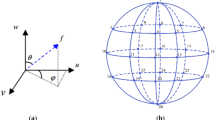Abstract
Convenient and non-invasive ultrasonography has become an essential tool for diagnosing fetal abnormalities. However, the noisy and blurry nature of sonographic data poses a challenge. To improve object visualization, we first develop a modified diffusion filter that utilizes the local standard deviation and edge of local-average-difference to define an adaptive edge stopping function in diffusion filtering. The proposed method overcomes the drawbacks of traditional diffusion filters and shows good results in comparative experiments. Moreover, we propose a novel light absorbing function to remove large regions of interface artifacts. An advanced imaging mode, called texture-based rendering, is employed to provide more realistic rendering. Experimental results show that the proposed methods enhance final image quality in 3D fetal sonograms.








Similar content being viewed by others
References
Beier T, Neely S (1992) Feature-based image metamorphosis. In Comput Graph Proc SIGGRAPH’92 26(2):35–42
Bullitt E, Aylward SR (2002) Volume rendering of segmented image objects. IEEE Trans Med Imaging 21(8):998–1002
Chang RF, Wu WJ, Tseng CC, et al (2003) 3-D Snake for US in margin evaluation for malignant breast tumor excision using mammotome. IEEE Trans Inf Technol Biomed 7(3):197–201
Crawford DC, Bell DS, Bamber JC (1993) Compensation for the signal processing characteristics of ultrasound B-mode scanners in adaptive speckle reduction. Ultrasound Med Biol 19:469–485
Czerwinski RN, Jones D, O’Brien W (1998) Line and boundary detection in speckle images. IEEE Trans Image Process 7(12):1700–1714
Downey DB, Pretorius DH, Fenster A, Nelson TR (May 1999) Three-dimensional ultrasound, Lippincott Williams and Wilkins, Philadelphia
Fattal R, Lischinski D (2001) Variational classification for visualization of 3D ultrasound data. Proc IEEE Vis 21–26:403–410
Gupta S, Chauhan RC, Saxena SC (2004) Wavelet-based statistical approach for speckle reduction in medical ultrasound images. Med Biol Eng Comput 42:189–192
Gupta S, Chauhan RC, Saxena SC (2005) Robust non-homomorphic approach for speckle reduction in medical ultrasound images. Med Biol Eng Comput 43:189–195
Hauser H, Mroz L, Bischi GI, Groller ME (2001) Two-level volume rendering. IEEE Trans Vis Comput Graph 7(3):242–252
Karaman M, Kutay MA, Bozdagi G (1995) An adaptive speckle suppression filter for medical ultrasonic imaging. IEEE Trans Med Imaging 14(2):283–292
Lee JS (1980) Digital image enhancement and noise filtering by using local statistics. IEEE Tran Pattern Anal Mach Intell 1–2 (2): 165–168
Levin A, Lischinski D, Weiss Y (2004) Colorization using optimization. In: Proc ACM SIGGRAPH Conference, pp 689–694
Levoy M (1988) Display of surface from volume data. IEEE Comput Graph Appl 8(3):29–37
Loizou CP, Pattichis CS, Christodoulou CI et al (2005) Comparative evaluation of despeckle filtering in ultrasound imaging of the carotid artery. IEEE Trans Ultrason Ferroelectr Freq Control 52(10):1653–1669
Lorensen WE, Cline HE (1987) Marching cubes: a high resolution 3D surface construction algorithm. Comput Graph Proc SIGGRAPH’87 21(4): 63–169
Merz E.(2005) Current 3D/4D ultrasound technology in prenatal diagnosis. Eur Clin Obstet Gynecol 1(3):184–193
Nelson TR, Elvins TT (1993) Visualization of 3D ultrasound data. IEEE Comput Graph Appl 13(6):50–57
Perona P, Malik J (1990) Scale-space and edge detection using anisotropic diffusion. IEEE Trans Pattern Anal Mach Intell 12(7):629–639
Pratt WK (1977) Digital image processing. Wiley, New York
Sakas G, Walter S (1995) Extracting surfaces from fuzzy 3D-ultrasound data. In: Proceedings of SIGGRAPH ‘95, pp 465–414
Sakas G, Schreyer LA, Grimm M, (1995) Preprocessing and volume rendering of 3D ultrasonic data. IEEE Trans Vis Comput Graph 15(4): 47–54
Shung KK, Smith MB, Tsui, Benjamin MW (1992) Principles of medical imaging. Academic, New York, pp 90–91
Souza A, Udupa JK, Saha PK (2005) Volume rendering in the presence of partial volume effects. IEEE Trans Med Imaging 24(2):223–235
Steen E, Olstad B (1994) Volume rendering of 3D medical ultrasound data using direct feature mapping. IEEE Trans Med Imaging 13(3):517–525
Sun Q, Hossack JA, Tang J, Acton ST (2004) Speckle reducing anisotropic diffusion for 3D ultrasound images. Comput Med Imaging Graph 28:461–470
Tauber C, Batatia H, Ayache A (2004) A robust speckle reducing anisotropic diffusion. ICIP ‘04 1:247–250
Tiede U, Höhne KH, Bomans M, Pommert A, Riemer M, Wiebecke G (1990) Investigation of medical 3D-rendering algorithms. IEEE Comput Graph Appl 10(2):41–53
Varandas J, Baptista P, Santos J, Martins R, Dias J (2004) VOLUS: a visualization system for 3D ultrasound data. Ultrasonics 42:689–694
Wang SR, Sun YN, Chang FM, Jiang CF (1999) 3D image display of fetal ultrasonic image by thin shell. Proc SPIE 3661:1478–1488
Weng TL, Lee TY, Sun YN (1998) New rendering method: scan-line based semi-boundary algorithm. Proc SPIE 3335(20):20–27
Wu M, Fraser RF, Chen CW (2004) A novel algorithm for computer-assisted measurement of cervical length from transvaginal ultrasound images. IEEE Trans Inf Technol Biomed 8(3):333–342
Yatziv L, Sapiro G (2006) Fast image and video colorization using chrominance blending. IEEE Trans Image Process 15(5):1120–1129
Yu Y, Acton ST (2002) Speckle reducing anisotropic diffusion. IEEE Trans Image Process 11(11):1260–1270
Acknowledgments
This work was supported in part by the National Science Council, Taiwan, under grant NSC 89-2213-E-006-065. The authors would like to offer their sincere thanks to Mrs. Y. Q. Zheng, Department of Obstetrics and Gynecology, National Cheng Kung University Hospital, for providing the ultrasound image dataset and special medical expertise; and also thanks to Professor Pai-Chi Li, Department of Electrical Engineering, National Taiwan University, for providing the speckle-simulating program.
Author information
Authors and Affiliations
Corresponding author
Appendix
Appendix
The following is the derivation of the normal vector.
Substituting the coordinates of P s and N i into (A1) yields
where × denotes the cross product operation. To simplify the equation, we define ∇ D i as D i −D s so that
After expanding the cross product, (A3) becomes
Rights and permissions
About this article
Cite this article
Wang, SR., Sun, YN. & Chang, FM. Artifact removal and texture-based rendering for visualization of 3D fetal ultrasound images. Med Biol Eng Comput 46, 575–588 (2008). https://doi.org/10.1007/s11517-007-0286-7
Received:
Accepted:
Published:
Issue Date:
DOI: https://doi.org/10.1007/s11517-007-0286-7




